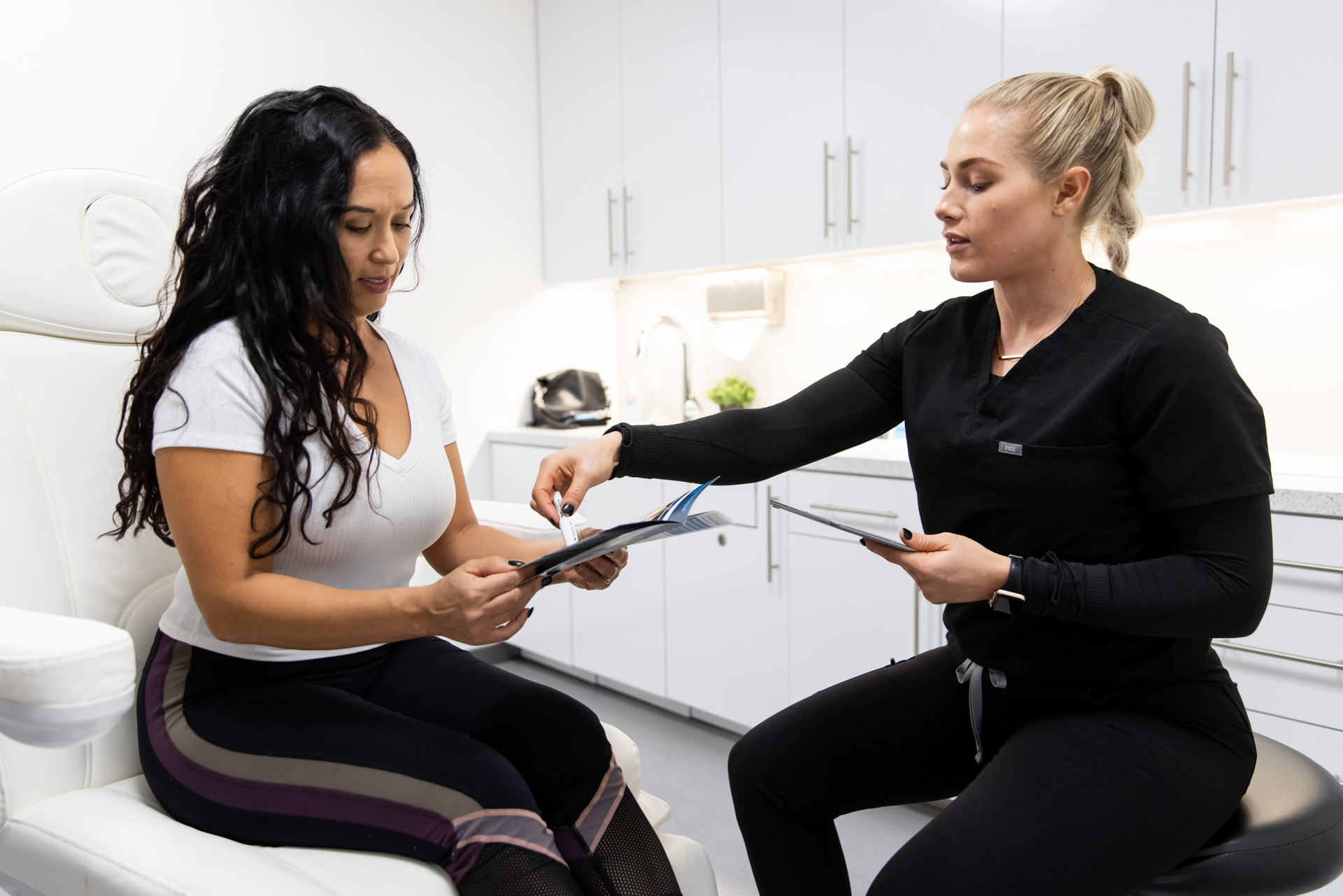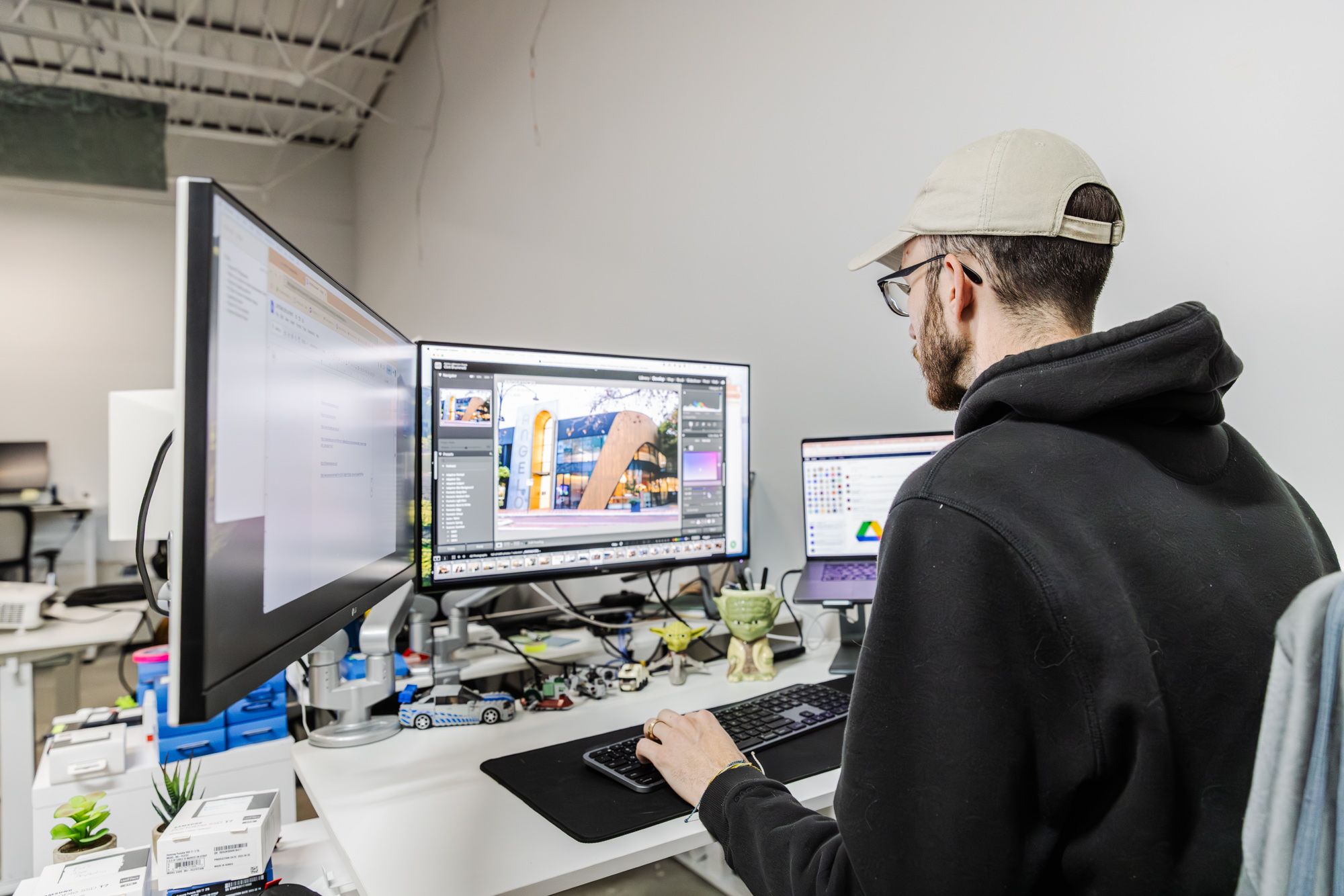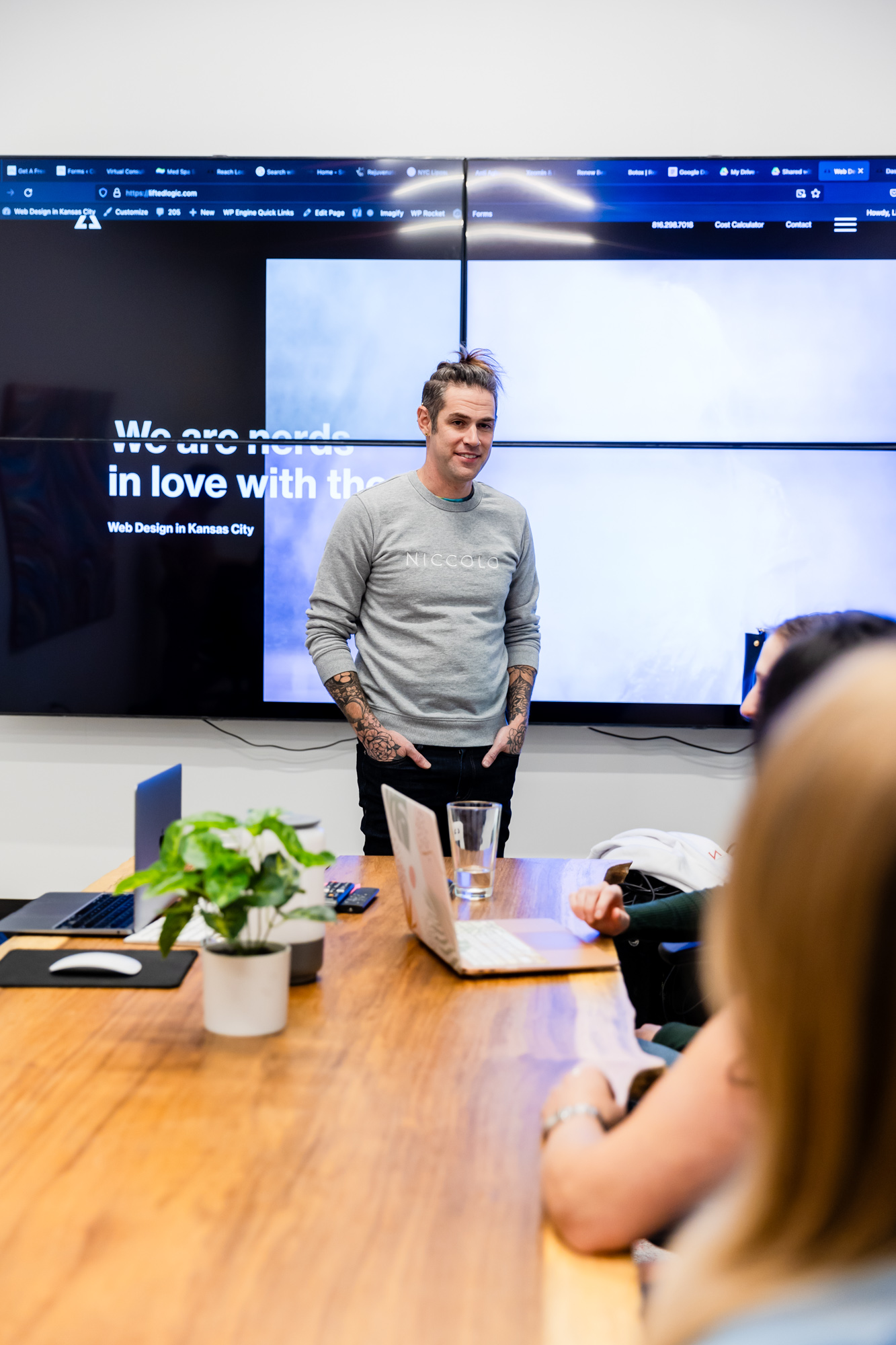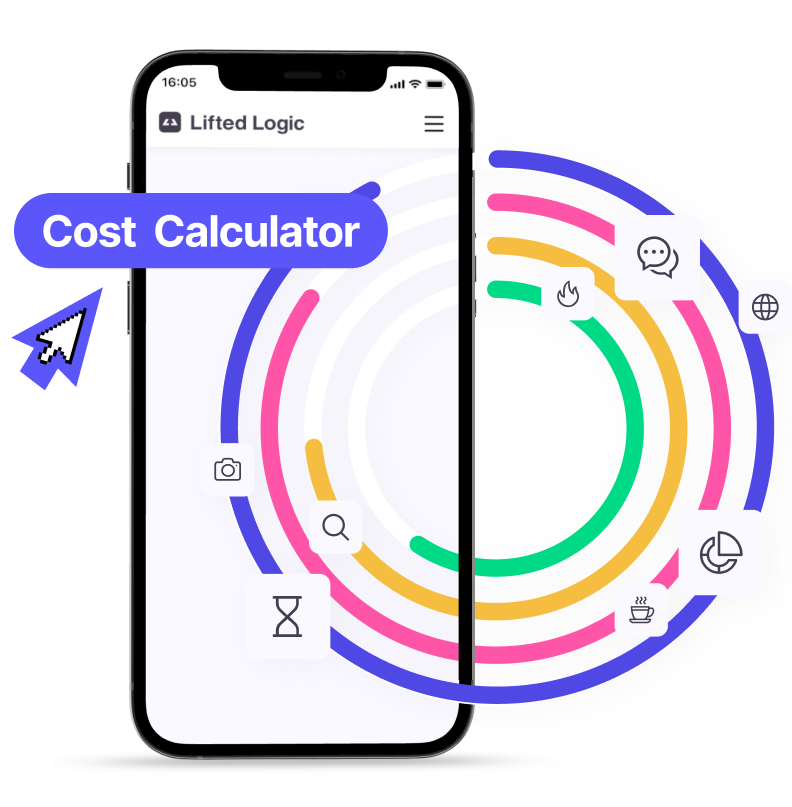So, you’re looking to optimize your medical spa content, increase brand awareness, drive traffic, and ultimately convert leads. Luckily, you’ve stumbled upon a blog post from the medical spa SEO content experts!
Lifted Logic is an award-winning web design agency absolutely filled to the brim with web-loving, design-obsessed, content-creating nerds. We’ve been crafting customized websites and SEO content for clients, medical spas very much included, for over 10 years.
So let’s back up a little! Is it accurate to say you’ve simply “stumbled upon” this blog? Have the search engine Gods chosen to bless you with this content out of sheer love? Maybe 🤷♀️But most likely it’s because we’ve utilized SEO to strategically place this very blog in your line of vision. Curious how to do that with your own content? Well, you can bet we’re gonna tell you.
What is SEO?
Let’s start with the basics: SEO is an acronym that stands for search engine optimization. It’s a process that anybody can go through to get their content ranking higher in the search results.
Search engines like Google, Bing, and Yahoo make indexes of absolutely every post on the internet. Their goal is to rank each post using a variety of factors. Based on these rankings, the search engines determine the order in which each post should appear in the search results.
The process of search engine optimization gives search engines more reason to put your content first on a search engine result page (SERP), thus garnering more traffic to your site.
Medical Spa SEO & Why It Matters
If you’re not super familiar with SEO, it can be hard to understand why it makes such a big difference. For medical spas in particular, increased user interaction with your online content can be a game changer. Let’s look at the main reasons medical spa SEO is so important for your business.
1. Drive traffic
The main reason you want to utilize SEO for your medical spa is to drive new and returning traffic to your site. The more users engage with your site, the more likely it is that they will convert to leads—which means more potential revenue for you!
When your blog and website content are optimized for search, your content ranks higher and is more accessible to the public. This includes treatment pages, provider information, and more.
2. Raise brand awareness
Two things happen when you utilize SEO correctly for your med spa:
- More users see your brand, read your content, and interact with your site. These could be returning users, but they could also be people unaware of your brand but looking for a service you offer. This increased awareness garners trust from your current user base and introduces you to an untapped market.
- Search engines begin to rank your site as more reputable, which gives you credibility online. This is called domain authority. Search engines look at domain authority as a qualifying factor for higher placement in the SERP. So, websites with higher domain authority often show up in the top search results.
As these things continue to happen, your brand ultimately becomes more visible and more credible.
3. Fill a need
There is a high demand for medical spa information. People search medical spa queries such as “laser treatment for acne scarring” with significant volume each month. They want the answers to their medical spa questions. Why not be the brand to answer them?
High search volume means there is a lot of demand for content surrounding that query. It also means there’s room to take different angles when providing that information. If your website is the first thing a potential lead comes across when looking for aesthetic services, you’re in a good position to fill that need for them.
4. Gain quality vs quantity leads
When you correctly utilize medical spa SEO, it is more likely that you’ll attract leads that want to convert. Let’s say, for example, you write a blog post about CO2 laser resurfacing using medical spa SEO best practices. Done correctly, the content can attract both users who are ready to spend money on that particular treatment, as well as those who are doing initial research before deciding on a treatment.
Ultimately, you can have 1,000 new users on your website. But if only 3 of them convert, the other 997 were wasted opportunities. The goal is not necessarily to increase the number of users, but the quality. SEO makes sure your content gets to people who want what you’re offering, and that you’re offering what people want.
5. Educate and inform
Medical spas are a part of the medical community. Therefore, it is imperative that you make credible and reliable claims regarding health and wellness for those searching for it. The more you’re able to accomplish this, the more credibility you garner with potential patients, who consistently want to be informed prior to an appointment. If people feel safe and informed by your brand, they are more likely to use your services.
If you want to learn more about how SEO content can drive your online traffic, check out this Ted Talk done by our very own boss man and SEO expert, Adam Fichman ⬇️
Now that you’ve learned the basics of SEO, let’s dive into how to create custom content using SEO best practices.
It’s all about keyphrases
The keyword or keyphrase is the backbone of medical spa SEO content creation. When you create content with the intention of driving quality leads to your website, you need to choose a keyphrase that will indicate what you are talking about in your article. Then, when people search for that keyphrase, your article will appear with all the answers (and tons of links to your site)!
User intent
The first step to choosing a keyphrase is understanding user intent. If your goal is to provide relevant information, then you have to make sure the content lines up with what potential patients search for. Let’s take a look at some examples of medical spa SEO keyphrases and their corresponding user intent.
| Keyphrase | User Intent | Anticipated Results |
| Medical spa services | Find treatments | Comprehensive service page |
| Esthetician | Find a job | Careers page |
| Best medical spas near me | A comprehensive, geography-based list | Directory site |
| What is dermaplaning? | Research/definition | Educational blog |
| Botox price per unit | Shopping | Pricing page/Botox page |
| How much should I spend on laser hair removal? | Budgeting advice | Explanatory article with price ranges |
| Plastic surgery vs. medical spa services | Comparison | FAQ, informative article |
If you’ve got “esthetician” as your keyword for your “about us” landing page, then, the user intent might not match up in the way you’d like it to. People searching for “esthetician” are more likely looking for a careers page, whereas “best aesthetician near me” would be more suitable for an “about us” page.
How did we figure this out? We spend a lot of time on Google. The best way to identify the user intent of any given medical-related keyphrase is simply to search it yourself! Google will show you what they are already populating for this key term in your area. Doing this gives you a good idea of not only how you could serve that user intent the best, but also how to do it better than the other websites that are already showing up on that page!
Basically, if you can decide what your user will be searching, and then create medical spa SEO content answering those queries, you’re more likely to pop up in the search results.
But most importantly, your content will match what the user is looking for, which will garner more quality leads for you. If the content doesn’t match the intent, then all of your hard work is for naught 😥
How do you know what people are searching for? Well, that leads us to the ever-powerful keyphrase research.
How to do keyphrase research
Now that you understand user intent a little bit better, it might be time to evaluate your keyphrase choices for each of your pages using keyphrase research! You can perform keyphrase research before you write any and all content for your website, whether it be a blog, a treatment page, or a specials page.
A great example of incorrect optimization typically occurs on a Botox page. Lots of medically minded people (like the ones who may or may not be running your medical spa!) like to include the word “neurotoxin” in their keyphrase for a Botox page.
That would be just fine if only doctors and aestheticians were searching for Botox. But chances are it’s just the regular old plebs like us, and truth be told, we have no idea what a neurotoxin is, much less how to type it into a search bar. Personally, if we were looking for Botox providers near us, we’d search… “Botox near us.”
Thinking about how you would search for the service you’re offering can help you start planning keyphrases. But don’t worry, it’s not all guess work. You can utilize sites like Google’s Keyword Planner, Google Trends, and even paid tools like Moz Keyword Explorer to get a better understanding of which keyphrase to use and when to use them.
Using a keyword planner
First, you’ll plug your keyphrase idea into one of these sites. You’ll acquire a wealth of knowledge about the phrase, like how many times a month users are searching it and how competitive the phrase is.
There are a few main metrics you can measure when selecting your medical spa related keyphrases:
- Monthly Volume: the number of times people search that term in a given month on average
- Competition/Difficulty: A score of how many other websites are trying to rank for these keyphrases, be it organically or through paid advertising
The dream is finding a keyphrase with a high search volume (at least 500 to 1,000) and a low competition rate. That rarely happens, so finding one in the middle ground is great. Let’s continue using our Botox vs. neurotoxin concept to look at some examples.
First we’ll start to do keyphrase research using the phrase, “botulinum neurotoxin treatment.”

As you can see, the keyphrase “botulinum neurotoxin treatment” boasts of a monthly search volume of less than 10 people. The difficulty is fairly high, probably because it would be hard to rank for content nobody is searching for 🥴
Now let’s look at the keyphrase research for the phrase, “Botox near me.”
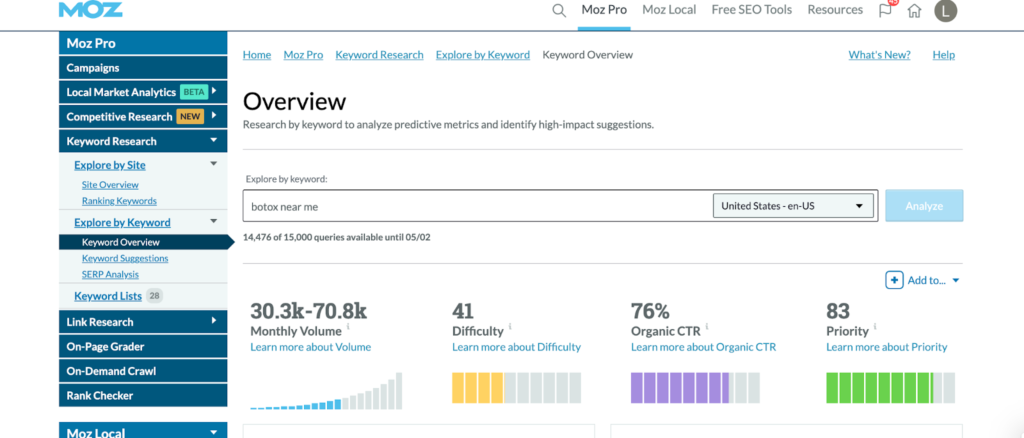
The volume for this keyphrase is much higher AND has a lower difficulty level. The more people are searching for it, the more demand there is for content. That makes you the supplier! This keyphrase is pulling ahead as the front-runner.
Next, let’s take a look at the existing SERP for this keyphrase.

Here are the top 4 search engine results for the keyphrase, “Botox near me.” Keep in mind that this SERP is representative of the Kansas City area, because that’s where our awesome office is located.
Looking at the existing SERP for this keyphrase shows us that the user intent matches the content you’d like to put out. People searching this phrase seem to be looking for Botox services, medical spas, and information about Botox. This would make it a fantastic keyphrase for your Botox treatment page!
You’ve officially completed keyphrase research. Wonderful job! You can begin the process of keyphrase research with your existing pages to figure out if they are lining up with user intent for the way you would like them to convert. Use this process for blog content, page content, and any other content that lives on your site!
Pro-Tip: Avoid keyphrase cannibalization
Over time, it can be tempting to use the same keyphrase for multiple blogs or treatment pages. But that would be keyphrase cannibalization, and if it sounds scary, it’s because it is!
Let’s say your HydraFacial page is ranking fifth for the keyphrase “hydrafacial near me”. In order to improve your ranking for that term, it’s not as easy as writing a huge blog optimized for that same term. At that point, you’d just be competing with yourself. (Or, more thematically, biting the hand that feeds you.)
Instead, if you want to improve how your HydraFacial page ranks, you should add additional, search-engine-optimized words to the existing page. Increasing your word count and number of internal links can boost your ranking and domain authority Plus, the more relevant information you have in your content, the more likely people are to interact with it. Just make sure that with additional word count, you include additional instances of the keyphrase.
How many times should you repeat a keyphrase in your med spa content?
There is such a thing as using a keyphrase too many times. This is referred to as “keyphrase stuffing” and neither human people nor Google robots like it.
First and foremost, you’re writing your article for people. When you use a keyphrase too many times it becomes difficult to read, and your audience isn’t getting the substantive information you want them to have. Google can also tell when you’re “breaking the rules” by keyphrase stuffing, which decreases your domain authority and harms the value of your content.
You should aim for about .5 – 2% of your content to contain your keyphrase. That means for a blog post of 750 or less words, you should use your keyphrase around 4-7 times. In a 750 to 1,500 word post, you should use your keyphrase around 7 to 10 times. You can use it more if it sounds natural, but be aware of your usage.
Localizing
Let’s say your medical spa is located in good ol’ Lawrence, KS. Let’s also say you’re writing a blog with the keyphrase, “medical grade skin care.” There are two things to note about the use of this keyphrase:
- The user’s intent is to find some medical grade skin care, but chances are they’re not looking to drive more than 15 miles to get it.
- With the current phrasing, you are competing nationally with all other content about medical grade skin care.
The solution is to localize. Localizing the keyphrase simply involves attaching your location to the end of it. So, it would look like, “medical grade skin care in Lawrence.” That way, when people who are in Lawrence search “medical grade skin care” or “medical grade skin care near me,” your article pops up.
When you localize your medical spa SEO keyphrase, you’re no longer competing with thousands of other pieces of content. And the user who clicks on your content will be in the same city as your med spa! Pretty dope, right?
Another exciting benefit of localization is that once you’re ready to begin expanding your market, you can simply localize to the nearest metropolitan area. Your keyphrase now changes to, “medical grade skin care in Kansas City” and voila–you’re showing up on the SERP for people in Kansas City (or wherever you’re from).
The key with localizing medical spa SEO is to start small. When you first begin your SEO journey, it can be difficult to rise to the top of the ranks of extremely difficult terms that you’ve never shown up for before. Start by optimizing your website content for the city in which you’re physically located (yes, even if it’s a township). As your website builds authority over time, you can begin breaking into other small pockets of your area, and finally, graduate on to writing for your entire metro area.
The two types of SEO
Keyphrases are certainly the main way to optimize your content, and you can never really be too versed in understanding them. But there are a few types of SEO, and each comes with their own methods of optimization.
On-page SEO
You can implement on-page medical spa SEO anywhere on your site. If words are living on a page, you should optimize them for SEO with keyphrase insertion. “On-page” can mean your landing page, your laser treatment page, your blog about injectables, or anything else that lives on the page!
When posting your content, there is a hierarchy of text. For example, the title should be the H1. Any subheaders under the original title will be H2, and so on. Adding the keyphrase to the most important headers on the page (naturally, of course) can boost your SEO. So make sure you have an instance of the keyphrase in your title and at least a few of your major headings.
On-page SEO also includes instances of keyphrase insertion in the back-end of your site. For example, it can help you rank for a keyphrase if those words appear in the alt text of an image on the page. Here’s an example of what that looks like:
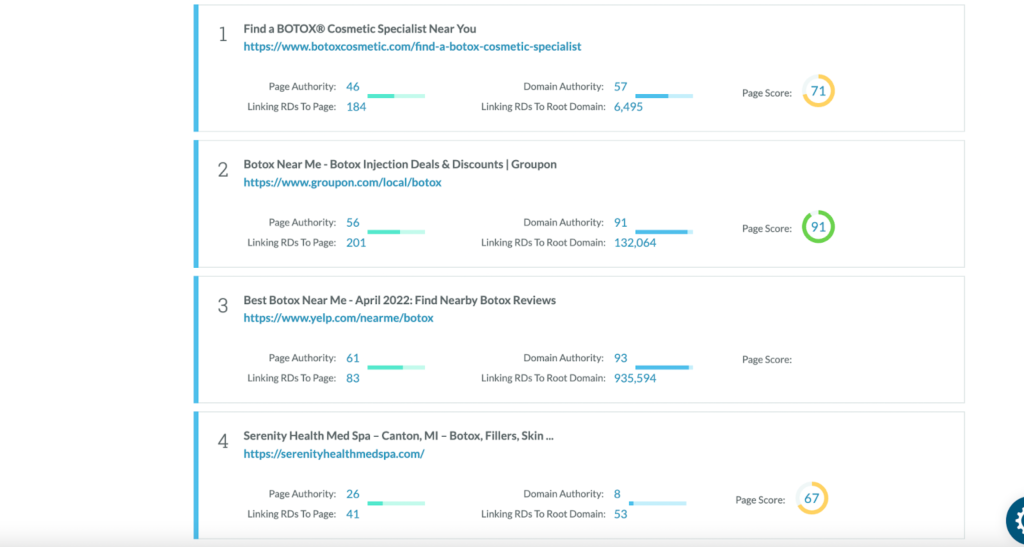
If you’re in WordPress, simply insert the image you would like to use, and then toggle over to text. Don’t be alarmed by the long, scary code language. As english-language-loving content creators, we’ve stifled our fear of the zeros and ones and learned that code is our friend 🥰
You can use command + F to find “alt=”. You’ll insert the alternative text including your keyphrase in between the two existing quotation marks. As you can see above, the keyphrase for this blog by Lifted Logic is “professional headshot in Kansas City.”
Now you’ve got a whole other instance of the keyphrase in your content. Even though this will ultimately go unseen by most readers, search engines like Google see everything 👀 Ultimately, though, search engines are not smarter than people. One way that they make connections about what your content is referring to is through links.
When you use links in your content, Google is able to contextualize the content. There are two types of links you can add to your on-page content.
Internal linking
These are links embedded into your content that take the user to a different page on your website. Let’s say you have a page about your dermal fillers, and your content discusses the difference between fillers and Botox.
You can link over to your Botox page so that a user can quickly and easily find that page as well. It’s about anticipating a user’s wants, and giving them easy access to the solution.
Once you’ve done this and published the content, Google understands that Botox and fillers have similarities and are linked together on your website. Now when people search for Botox, they might find links to both your Botox page and your dermal filler page.
External linking
External linking is the act of linking your content to other reliable sources. Each website accrues something called domain authority. This refers to the reliability of that source as defined by search engines algorithms. (You may have also heard of this referred to as the E-A-T criteria: expertise, authoritativeness, and trustworthiness.)
Let’s say in your blog post about liposuction, you link to a reputable, informative source detailing the risks and rewards of liposuction. The act of citing a credible website as a reference gives search engine, and users, reason to believe your content is more reliable.
Off-page SEO
Off-page, or off-site, SEO refers to optimization that occurs anywhere that is not the page. A lot of this has to do with domain authority, and a fantastic tool to build domain authority is through backlinking.
A backlink is any link from a different web page that directs traffic to your site. An example would be if a site created a list of the top medical spas near you and included a link to your site.
One way to boost the number of backlinks you’re receiving is to reach out to high-credibility sites. If you’re able to consistently link to a medical information site, they may want to build a partnership in which you both backlink to the other’s site.
Off-page SEO matters because while keyphrases and other ranking factors sometimes change, the trustworthiness of your website is a consistent element that search engines look at when ranking content. The more consistently your site is proven to be credible by outside sources, the higher you will rank in any given SERP against your competitors.
Additional tools | SEO vs. paid advertising
When it comes to SEO and paid advertising, we like to think of it as less of an epic rap battle and more of a collab. Paid advertising is simply an additional way to drive new users to your website and can help supplement your content in places where you might be finding it more difficult to rank organically. When done well, paid advertising efforts use SEO best practices.
What is PPC?
Paid digital advertising uses a pay-per-click (PPC) / cost-per-click (CPC) model and is an avenue of traffic for businesses looking to increase brand awareness, lead generation, and website conversions. PPC campaigns can include Google or Bing ads, social media ads, Youtube ads, and any other methods of paying to promote your brand, services, or products anywhere that is not a domain that you own.
You’re probably already familiar with this, you just may not realize it. Imagine you open up Google and type in “body contouring near me.” The first handful of search results on the page will tell you that they are paid advertisements by bolding the word “Ad” next to the URL—like this ⬇️
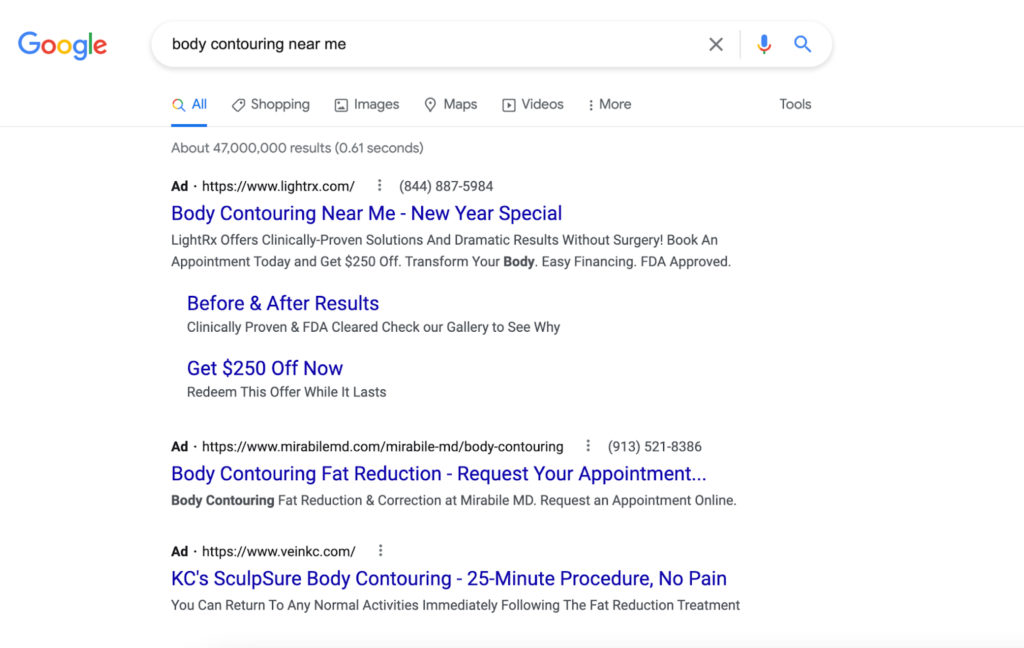
These are campaigns that paid money to rank above everyone else. Everything below these results is ranking organically through the power of SEO. To put it in website speak: SEO is to organic traffic as PPC is to paid traffic.
But it’s not as simple as it sounds…
In order for Google or another search engine to rank your advertisement at the top of the list, they need a little bit more than money. That’s where medical spa SEO comes in. Employing SEO strategy when creating advertising campaigns by using a consistent keyphrase across your ad text, landing pages, digital assets, and more is how to truly please the search engine Gods.
Paid advertising for medical spas: playing by the rules
Whoa whoa whoa, not so fast. Not everyone will allow medical spas to “pay to play”—at least without jumping through a few extra hoops. For example, Google has several policies in place regarding medical advertisements in the United States, including a long list of restricted drug terms that contains Botox, Restylane, Dysport, and most injectables. But don’t panic! We can help our medical spa clients run paid advertising in their areas. It’s just a matter of weighing cost and reward.
1. Budget wisely
Violating policies doesn’t mean your ads won’t run, but it could mean your cost per click is higher than you expect. There are many different factors that impact budgeting decisions, but med spas should account for a little extra coin.
2. Stay updated
Our secret weapon as Google advertisers is simply staying updated on the rules. That’s how you become the best player. These policies may seem strict, but the misconception is that they seem new. While Google is constantly evolving (as is the medical spa industry), medical advertisements have long been prohibited without proper approval.
In other words, speeding on the highway has always been illegal, it’s just that there are more cops out now than ever before. Don’t get caught without your seatbelt 😉
Tips on writing med spa blog content
1. Keep it evergreen
You’re going to want to use your content for as long as you can. Keeping something evergreen means it’s universal enough to stay relevant for years to come. Stay away from mentions of very specific cultural moments or timely situations because you don’t want to push away the audience as the post ages.
You should also avoid mentioning events or specials that might expire—otherwise, you may have some very confused patients on your hands in the future!
2. Embed videos and other media
Use all of the tools in your tool kit when writing your medical spa blog content! If you have a video about one of your treatments, throw that bad boy into your blog.
Add at least two photos to a blog post of 700 words or more. (And don’t forget to use the alt text of the image to include another instance of your keyphrase!)
You can even embed social posts if you’ve recently discussed a specific topic or treatment on your Instagram, Facebook, Twitter, etc. This doesn’t necessarily help you rank better, but it does make your content more engaging!
3. Identify your brand tone
If your brand were a person, who would they be? Decide on a tone you’d like to use to write your SEO content. This could be formal and professional, informative, approachable and casual, inspirational, and so on. Based on the tone, you can decide whether to use first-person or third-person in your writing. Just make sure to stay consistent throughout your content!
Additionally, decide on what words your brand likes and doesn’t like. Like, seriously, make a list! Use more of the words you like, and none of the words you don’t. You are in charge of how the content comes across to the readers. Have fun with it!
You can also decide if contractions are okay in your writing. Typically, contractions indicate a more relaxed and casual tone. Stay consistent with your brand tone as you write your content.
4. End on a call-to-action
At the end of each of your blogs, decide what action you would like your readers to take. This call-to-action (CTA) could be anything from, “Sign up for our newsletter!” to “Book an appointment today!” Use that call to action as the header and then write a small section about how to perform the CTA. Make sure to include a link to the page you want to get them to!
Examples of Good Med Spa SEO Blogs:
- A Guide to Permanent Lip Augmentation
- The Best Laser Treatment for Aging Hands
- Everything You Need To Know About Cosmetic Injectables
- Body Contouring 101 | Everything You Need to Know
- Vaginal Rejuvenation | How It Works
- Xeomin vs Botox | Which Neurotoxin Is Right for Me?
- The Basics of LaseMD for Hair Loss
How to tell if SEO is working for your medical spa
You’ve made it pretty far into this blog. So, let’s get to the good stuff–results. There are a few resources you can use to determine the effects of optimized content.
Google Analytics
Google Analytics is a free online resource for business owners and operators. You can use it to track website traffic and measure conversions, among many other things.
Once you’ve set up your account, you can see how many new users have arrived on your site, where exactly they came from, and if they’re converting. You can also use it as a way to measure the overall health of your website.
For example, Google Analytics offers the ability to track traffic coming from SEO content like newsletters. If someone clicks on the link to your landing page from the newsletter, Google Analytics tracks that click. If leads are converting well from that page, you can focus your marketing efforts on it.
Google even provides an online training course so you and your team can properly utilize this invaluable resource.
Yoast on WordPress
If you use WordPress, you can acquire a plug-in called Yoast. When you go to post your blogs and custom content, the Yoast plug-in automatically analyzes your SEO and ranks it. This helpful tool will give you tips on how to increase your SEO ranking.
Take a look at how this shows up on the back end:

All this information is easily accessible with the Yoast plug-in. It uses a simple and universal value system of colored smiley faces. Red angry face means you’re doing a bad job at SEO 😡
Yellow neutral face says you could do better 😐And a green happy face indicates your SEO content is optimized! As you can see, we got the green smiley face on this blog we posted last year. ‘Cuz our writers rock 😇
You can also see, however, that there were a few places we could have done even better, including:
- Using the keyphrase in the introduction
- Putting keyphrase in more of the subheadings
If you want to know more about how to post blogs in WordPress, check out this blog we wrote about it!
Ask your front desk staff
Let’s kick it old school with this one. There’s nothing quite like word-of-mouth. Did you recently post content about dermaplaning? Ask your team at the front desk whether they’ve seen an increased number of phone calls regarding that treatment. You can even have guests fill out a questionnaire with a question about their referral source.
When in doubt, take a look around the spa. Have things seemed busier the past few weeks? It’s not a surefire way to measure your growth, but the ultimate goal is to bring you more business. If that seems to be happening, then more power to you!
Listen to your patients
Are patients calling to ask you a specific question over and over? Do you tire of these questions and lament, “I don’t know why they don’t just look on the website?!” Chances are the website is not displaying information in a way that’s easy for your users to find it.
Okay, technically this is a way for you to tell what’s not working as opposed to what is, but that’s exactly how you can tell where you need to improve.
💡 Here’s a pro-tip for you: Set someone down in front of your website and give them one minute to look through it. Don’t direct them in any way. Just allow them to naturally explore your website as they would if they were a potential customer.
After one minute, stop them and ask them to tell you about your services. You may be surprised at the information they saw, and maybe even more surprising, the information they didn’t!
Good web design is critical for SEO
Ultimately, everything we’ve discussed in this blog, from SEO keyphrases, to user intent, to linking, is small apples compared to how your website performs.
SEO and good web design go hand-in-hand. There are many things about your website’s user experience (and therefore, its ability to rank) that you can’t control in your content alone. Ensuring that the pages load quickly, pictures appear with good quality, and the site is easy to navigate all affect your SEO performance. Those are things that require some beautiful web design.
Crafting a custom website is one of the most valuable ways to garner quality leads and boost your business. You can write fun and engaging content ‘til the cows come home, but you had better make sure they have a place to graze when they do!
The best way to ensure your website is doing its job is to sit down with Lifted Logic for a consultation regarding a custom-built website, or use our cost calculator to receive a custom estimate 💌
Medical spa SEO services
In addition to creating stunning custom websites, we provide ongoing SEO marketing services to those who desire them. When it comes to SEO, we’re pretty darn good at what we do. After all, we got this content in front of you, didn’t we? 😉
If you’re ready to set your business up for success, contact us today to learn more about our SEO services. We don’t bite 😇
